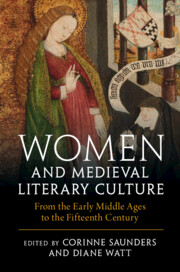Book contents
- Women and Medieval Literary Culture
- Women and Medieval Literary Culture
- Copyright page
- Contents
- Illustrations
- Contributors
- Acknowledgements
- Introduction
- I Patrons, Owners, Writers, and Readers in England and Europe
- II Circles and Communities in England
- III Health, Conduct, and Knowledge
- Chapter 7 Embracing the Body and the Soul
- Chapter 8 Gender and Class in the Circulation of Conduct Books
- Chapter 9 Women’s Learning and Lore
- Chapter 10 Women and Devotional Compilations
- IV Genre and Gender
- V Women as Authors
- General Index
- Index of Manuscripts
- References
Chapter 10 - Women and Devotional Compilations
from III - Health, Conduct, and Knowledge
Published online by Cambridge University Press: 28 July 2023
- Women and Medieval Literary Culture
- Women and Medieval Literary Culture
- Copyright page
- Contents
- Illustrations
- Contributors
- Acknowledgements
- Introduction
- I Patrons, Owners, Writers, and Readers in England and Europe
- II Circles and Communities in England
- III Health, Conduct, and Knowledge
- Chapter 7 Embracing the Body and the Soul
- Chapter 8 Gender and Class in the Circulation of Conduct Books
- Chapter 9 Women’s Learning and Lore
- Chapter 10 Women and Devotional Compilations
- IV Genre and Gender
- V Women as Authors
- General Index
- Index of Manuscripts
- References
Summary
Some late fourteenth- and early fifteenth-century compilations address both men and women, while employing the topos of the female religious reader to depict the exemplary Christian life for all. Other works offer specific connections with female, particularly aristocratic readers, both secular and religious. Book to a Mother explicitly addresses the mother of the author, a widow perhaps interested in joining a religious community while also addressing a lay public. As well as adapting anchoritic material, compilations also took up the spiritual teachings offered by Richard Rolleߣs vernacular writing. Disce mori, for example, both uses Rolleߣs texts and imitates the dynamics of Rolleߣs relations with his female readers, while also including a more general lay readership. Womenߣs writings, such as the Revelations of Birgitta of Sweden, play an important part too in compilations. Though evidence is scant, the example of Eleanor Hull suggests that women also acted as compilers. Compilations, then, demonstrate both the range and complexity of womenߣs involvement in devotional literary culture, and the wider significance of the female subject for devotional writers, male and female, in later medieval England.
Keywords
- Type
- Chapter
- Information
- Women and Medieval Literary CultureFrom the Early Middle Ages to the Fifteenth Century, pp. 206 - 226Publisher: Cambridge University PressPrint publication year: 2023



